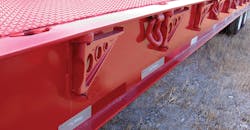A trailer is never just a trailer. It can be manufactured to many different specifications, but the end result should always be an ideal trailer for an operation’s specific loads. To select a trailer that will require the least amount of maintenance, provide the greatest lifespan and deliver the highest possible return on investment, it is vital to understand the trailer’s true capacity.
There are five contributors to capacity ratings, and each can be varied to meet a carrier’s specifications. To select the right trailer, operators should consider these factors:
Load concentration
There are no industry standards when it comes to determining capacity ratings. To ensure maximum utilization, operators need to pay special attention to load concentration, or the length of the deck that can handle the rated weight. Obviously, a 50-ton lowbed can haul 50 tons. But how much of the deck those 50 tons occupy is just as important as the weight itself. While one trailer might need the entire 26 feet to be rated at 50 tons, another can handle that same weight in half the deck length. Since loads are rarely 26 feet long, these ratings give a more realistic indication of the concentrated loads the trailer will be able to handle safely and without structural failure.
Load distribution
How a load is distributed over the deck and the number of required axles is also an important consideration when selecting the right trailer. Axle weight laws and regulations vary from state to state, so fleet managers and operators should work with manufacturers to define the best trailer for the cargo and the best axle configurations to maximize the load in their area of operation.
There are many options for achieving the best possible weight distribution over the axles, depending on the specific state’s regulations and the nature of the load. For example, carriers can vary gooseneck lengths in the front, alter the distances between axles and axle groups, move the load closer to one end or the other, or use a jeep dolly to add extra axles. However, these options must be included in the initial trailer design—simply adding them afterward risks the structural integrity of the trailer and the safety of operators and the public.
Speed
Another capacity determinant is speed. While some manufacturers rate their trailers at 55 mph, others rate them at 65 mph. The slower a rig travels, the less added weight or stress is placed on the trailer. This is due to the fact that, while road dynamics such as potholes, railroad tracks and so on still come into play, the impact on the trailer decreases along with the speed.
Safety
A trailer’s safety rating also comes into play when discussing capacity. A safety rating is an indicator of how much stress a trailer can safely handle. It encompasses factors such as the strength of the raw materials used in the trailer’s construction and how the beams and cross members are configured.
The widely accepted average magnification of payload weight on a trailer due to road dynamics is 1.8 to 1 ratio. However, on any given haul, stress on the trailer can go above that level multiple times. If no cushion is built in to handle those spikes in stress, there is potential for long-term, progressive structural damage. That’s why some industry-leading manufacturers use a ratio of 2.5 to 1, which is considered an ample cushion for even the most extreme road dynamics a trailer might encounter.
Not only does the safety rating tell a carrier how strong their trailer is, it’s also a very good indicator of potential life. Typically, the greater the difference between the static design safety factor and the dynamic 1.8 average multiplier, the longer a trailer’s useful life expectancy.
Materials
Safety factors are strongly related to the quality of the components incorporated into the trailer, such as steel and the deck material.
There are several options when choosing steel, but for the most capacity and smallest impact on the trailer weight, reputable manufacturers use a T1 material with 100,000 psi minimum yield. T1 has maximum strength versus ductility and equates to a lighter, stronger trailer frame.
A trailer’s decking is continually exposed to the elements, making durable decking with a long wear life crucial. Tightly woven and incredibly dense, apitong decking provides a tougher, longer lasting wood in comparison to other varieties, such as oak or pine. It’s also less susceptible to chipping and cracking, and provides some amount of traction in comparison to a smooth metal surface.
Help to be had
Purchasing the right trailer can be complicated, but there is help available. Many manufacturers have experienced staff who can help select a trailer with the optimal combination of load concentration, load distribution, speed and safety rating for specific applications and load types. Knowing a trailer’s true capacity will help ensure an investment that leads to a long, smooth ride.
Troy Geisler is the vice president of sales and marketing for Talbert Manufacturing. He has more than 15 years of experience in trailer sales, including more than five years with Talbert. Geisler earned his bachelor’s degree from Purdue University.
About the Author
Troy Geisler
Vice president of sales and marketing for Talbert Manufacturing
Troy Geisler is the vice president of sales and marketing for Talbert Manufacturing. He has more than 15 years of experience in trailer sales, including more than five years with Talbert. Geisler earned his bachelor’s degree from Purdue University.


